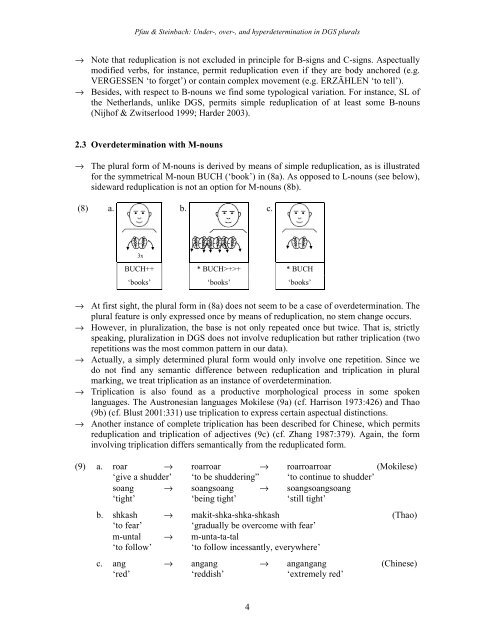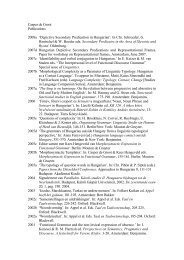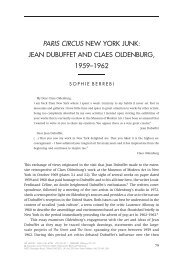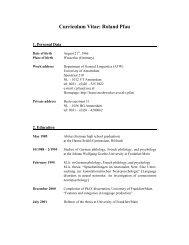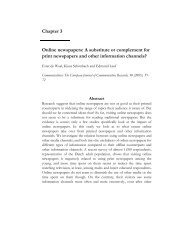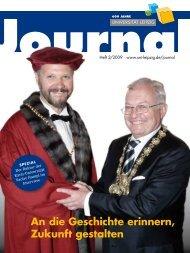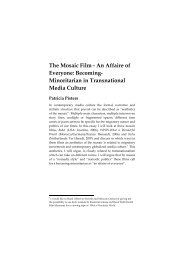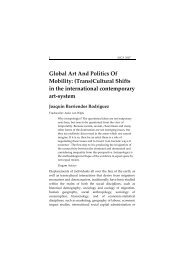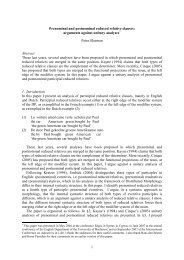Hyperdetermination in German Sign Language plurals
Hyperdetermination in German Sign Language plurals
Hyperdetermination in German Sign Language plurals
You also want an ePaper? Increase the reach of your titles
YUMPU automatically turns print PDFs into web optimized ePapers that Google loves.
Pfau & Ste<strong>in</strong>bach: Under-, over-, and hyperdeterm<strong>in</strong>ation <strong>in</strong> DGS <strong>plurals</strong><br />
→ Note that reduplication is not excluded <strong>in</strong> pr<strong>in</strong>ciple for B-signs and C-signs. Aspectually<br />
modified verbs, for <strong>in</strong>stance, permit reduplication even if they are body anchored (e.g.<br />
VERGESSEN ‘to forget’) or conta<strong>in</strong> complex movement (e.g. ERZÄHLEN ‘to tell’).<br />
→ Besides, with respect to B-nouns we f<strong>in</strong>d some typological variation. For <strong>in</strong>stance, SL of<br />
the Netherlands, unlike DGS, permits simple reduplication of at least some B-nouns<br />
(Nijhof & Zwitserlood 1999; Harder 2003).<br />
2.3 Overdeterm<strong>in</strong>ation with M-nouns<br />
→ The plural form of M-nouns is derived by means of simple reduplication, as is illustrated<br />
for the symmetrical M-noun BUCH (‘book’) <strong>in</strong> (8a). As opposed to L-nouns (see below),<br />
sideward reduplication is not an option for M-nouns (8b).<br />
(8) a.<br />
3x<br />
b.<br />
BUCH++ * BUCH>+>+ * BUCH<br />
‘books’ ‘books’ ‘books’<br />
→ At first sight, the plural form <strong>in</strong> (8a) does not seem to be a case of overdeterm<strong>in</strong>ation. The<br />
plural feature is only expressed once by means of reduplication, no stem change occurs.<br />
→ However, <strong>in</strong> pluralization, the base is not only repeated once but twice. That is, strictly<br />
speak<strong>in</strong>g, pluralization <strong>in</strong> DGS does not <strong>in</strong>volve reduplication but rather triplication (two<br />
repetitions was the most common pattern <strong>in</strong> our data).<br />
→ Actually, a simply determ<strong>in</strong>ed plural form would only <strong>in</strong>volve one repetition. S<strong>in</strong>ce we<br />
do not f<strong>in</strong>d any semantic difference between reduplication and triplication <strong>in</strong> plural<br />
mark<strong>in</strong>g, we treat triplication as an <strong>in</strong>stance of overdeterm<strong>in</strong>ation.<br />
→ Triplication is also found as a productive morphological process <strong>in</strong> some spoken<br />
languages. The Austronesian languages Mokilese (9a) (cf. Harrison 1973:426) and Thao<br />
(9b) (cf. Blust 2001:331) use triplication to express certa<strong>in</strong> aspectual dist<strong>in</strong>ctions.<br />
→ Another <strong>in</strong>stance of complete triplication has been described for Ch<strong>in</strong>ese, which permits<br />
reduplication and triplication of adjectives (9c) (cf. Zhang 1987:379). Aga<strong>in</strong>, the form<br />
<strong>in</strong>volv<strong>in</strong>g triplication differs semantically from the reduplicated form.<br />
(9) a. roar → roarroar → roarroarroar (Mokilese)<br />
‘give a shudder’ ‘to be shudder<strong>in</strong>g” ‘to cont<strong>in</strong>ue to shudder’<br />
soang → soangsoang → soangsoangsoang<br />
‘tight’ ‘be<strong>in</strong>g tight’ ‘still tight’<br />
b. shkash → makit-shka-shka-shkash (Thao)<br />
‘to fear’ ‘gradually be overcome with fear’<br />
m-untal → m-unta-ta-tal<br />
‘to follow’ ‘to follow <strong>in</strong>cessantly, everywhere’<br />
c. ang → angang → angangang (Ch<strong>in</strong>ese)<br />
‘red’ ‘reddish’ ‘extremely red’<br />
4<br />
c.


